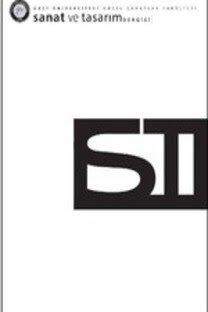BİLİMSEL GERÇEKLİK / İMGESEL İHTİMAL: SANAT PRATİĞİNDE DÜŞÜNCENİN OLASILIKLARINI ÇOĞALTMAK
Deneysel Pratik, Materyal Düşünce, Sanatsal Düşünce
SCIENTIFIC REALITY / IMAGINARY PROSPECT: EXPANDING THE POTENTIALITIES OF THINKING THROUGH ART PRACTICE
Experimental Practice, Material Thinking, Art Practice,
___
- • Agamben, G. (1979). Taste. Londra: Seagull Books.
- • Borgdorff, H. (2012). The Conflict of The Faculties: Perspectives on Artistic Research And Academia. Leiden: Leiden University Press.
- • Bourdieu, P. (2016 ). Akademik aklın eleştirisi: Pascalca düşünme çabaları. İstanbul: Metis.
- • Busch, K. (2011). Generating Knowledge in the Arts: A Philosophical Daydream. Texte Zur Kunst. Issue No. 82 / June 2011 “Artistic Research”. (s. 70-78).
- • Duve, T. D. (1999). When Form Has Become Attitude - And Beyond. Z. Kocur& S. Leung (Editörler) içinde, Theory in Contemporary Art Since 1985 (s. 19-31). Malden: Blackwell.
- • Elkins, J. (2009). Why art cannot be taught: a handbook for art students. Urbana: University of Illinois Press.
- • Flach, S. (2012). Through the Looking Glass Art and Science at the Time of the Avantgarde: The Example of Wassily Kandinsky’s Working Method In His Synthetic Art. Experimental Systems: Difference, Graphemacity, Conjuncture. F. Domboise içinde, Intellectual Birdhouse: Artistic practice as research (s. 125-138). Londra: Koenig Books.
- • Gielen, P. (2013). Artistic Practice and the Neoliberalization of the Educational Space. The Journal of Aesthetic Education, 58-71.
- • Groys, B. (2013). Sanatın Gücü. İstanbul: Hayalperest.
- • Hacking, I. (1984). Representing and Intervening Introductory Topics In The Philosophy of Natural Science. Cambridge: Cambridge University Press.
- • Heartney, E. (2011). Sanat ve Bugün. İstanbul: Akbank.
- • Heidegger, M. (1951). What is called thinking? New York: Harper Perennial.
- • Heidegger, M. (1977). The Question Concerning Technology, and Other Essays. New York: HarperCollins.
- • Hodder, I. (2018). Dolanıklık: Insanlar ile Şeyler Arasındaki Ilişkilerin Arkeolojisi. İstanbul: Alfa.
- • Holert, T. (2011). Artistic Research: Anatomy of an Ascent. Texte zur Kunst, 70-78.
- • Ingold, T. (2007). Materials against Materiality. Archaeological Dialogues, 1–16.
- • Ingold, T. (2013). Making: Anthropology, Archaeology, Art and Architecture. Londra: Routledge.
- • Latour, B. (1998). From the World of Science to the World of Research?.Science .Vol. 280, Issue 5361, 208-209.
- • Latour, B. (2004). Politics of Nature: How to bring sciences into Democracy. Cambridge: Harvard University Press.
- • Le Guin, U. (2015). Kadınlar Rüyalar Ejderhalar: Ursula K. Le Guin’den Seçme Yazılar. İstanbul: Metis Yayınları.
- • Lyotard, F. (1979). The Postmodern Condition: A Report on Knowledge. Minnesota: University of Minnesota.
- • Michelkevičius, V. (2018). Mapping Artistic Research. Towards Diagrammatic Knowing. Vilnius: Vilnius Academy of Arts Press.
- • Rheinberger, H. J. (1994). Experimental Systems: Historiality, Narration, and Deconstruction. Science in Context, 65-81.
- • Rheinberger, H. J. (2012). Experimental Systems: Difference, Graphemacity, Conjuncture. F. Domboise içinde, Intellectual Birdhouse: Artistic practice as research (s. 89-100). Londra: Koenig Books.
- • Shapin, S. (2008). The Scientific Life: A Moral History of a Late Modern Vocation. Chicago: University of Chicago Press.
- • Sheikh. S. (2006). Spaces For Thinking: Perspectives on The Art Academy. Texte zur Kunst 62. 191-196.
- • Singerman, H. (1999). Art subjects: Making artists in the American university. Londra: University of California Press.
- • Slager, H. (2012). The Pleasure of Research. Ostfildern: Hatje Cantz.
- • Tuin, I. v. (2018). Neo/New Materialism. R. B. Hlavajova içinde, Posthuman Glossary (s. 277-278). Londra: Bloomsbury Academic.
- ISSN: 1308-2264
- Yayın Aralığı: Yılda 2 Sayı
- Başlangıç: 2015
- Yayıncı: Ankara Hacı Bayram Veli Üniversitesi
''SOYLULAŞTIRMA'' KAVRAMI ÜZERİNDEN ÜRETİM YAPAN SANATÇILARA YÖNELİK BİR İNCELEME
TÜRKİYE'DE ÖZEL TİYATROLARA DEVLET YARDIMI: AMPİRİK BİR ANALİZ
Sacit Hadi AKDEDE, Şansel ÖZPINAR
İÇ MİMARLIK EĞİTİMİNDE ÖĞRENCİ PROFİLİ ODAKLI BİR DEĞERLENDİRME: BİR TASARIM STÜDYOSU DENEYİMİ
Özlem KURT ÇAVUŞ, Mustafa ÇAVUŞ, B.burak KAPTAN
FOTOĞRAF SANATINDA PORTRE TİPOLOJİLERİ
YAZI TASARIMINI ÖNEMSEYEN VE SAHİP ÇIKAN BİR KUŞAĞIN TEMSİLCİSİ: MUSTAFA EREN
MODA TASARIMI ÖĞRENCİLERİNİN TASARIM BİLİŞ TÜRLERİNİN BELİRLENMESİ
MODERNİTEYE KARŞIT POSTMODERNİTE: KENT PARKLARININ TASARIM KALİTESİNİN AHS İLE DEĞERLENDİRİLMESİ
Elif KUTAY KARAÇOR, Kıymet UZUN YÜKSEL, Berfin ŞENİK
FRANK LLOYD WRIGHT'IN MEKAN ANLAYIŞI: FREDERICK ROBIE EVİ ÜZERİNDEN BİR OKUMA
SÜRDÜRÜLEBİLİR TASARIM YAKLAŞIMI AÇISINDAN BİYOPLASTİKLERİN İNCELENMESİ
